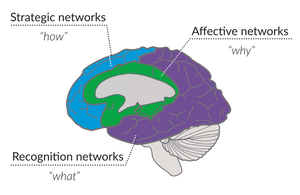
I have always been fascinated by neuroscience, by the way the brain accesses, processes, and responds to stimuli. As an educator, the more I know about the science behind the mind, the better I am able to design effective learning experiences for my students. The same is true when we develop professional development (PD) for adults. As we understand about how the brain works, we can consciously activate neural networks that support sustained learning.

Universal Design for Learning (UDL) is a framework, founded on neuroscience, with the aim of designing learning environments, lessons, and opportunities that meet the needs of ALL students. We don’t dumb down content, we activate brain networks that increase accessibility for learners. As we celebrate variability and reject a one size fits all approach, we more effectively meet the individual needs of each of our adult learners.
Since diving deeper into UDL principles and guidelines, I have begun implementing practices in PDs to align to the “Recognition Network”, by offering multiple means of representation.

One simple change I’ve made to all of my PDs is to turn on closed captioning to YouTube videos I play during sessions. I have had a few adults thank me for this iteration, as they are hard of hearing but do not wish to advertise this fact to everyone in the room. The most recent tool I have implemented is the new closed captioning feature in Google slides. This feature uses your device’s microphone to listen to your words and then display these words in writing on the bottom of the presentation. While it is not perfect, the voice recognition is quite accurate and is continuing to improve continually. I have led professional development sessions where Google slides picks up my voice and also provides a real time written record of questions verbally asked by participants. I displayed this new feature to a group of teachers before beginning a session a couple of weeks ago.

I asked these educators if they wanted me to leave the closed captioning feature on as we continued the session. The answer in this session as well as the one directly following was a resounding and enthusiastic “yes!”. To activate closed captioning in Google slides, open a presentation, click the button on the top right that reads “Present”, and select the “CC” button on the dark grey menu found on the bottom left of the screen. Educators have asked me if this closed captioning feature can be recorded on video. While a video feature is not currently native to Google slides, the Google Chrome extension Screencastify, used to create the animated gif seen on this blogpost, will add this functionality.
Another strategy I’ve begun using to increase access to professional learning is to provide multiple representation methods for participants to access content. As I plan a session, I work to include a mix of videos to view, text to read, podcasts to listen to, opportunities to learn by communicating with others and time to engage in activities for kinesthetic learning. Initially, the preparation time required to plan a session in this way is much more than if I designed an experience where teachers listen to a lecture style presentation. However, the benefits outweigh the costs. Educators again and again provide feedback that they appreciate not only the variety of resources presented, but the various methods in which they are available. Some people prefer to read a text regarding the content, others prefer to watch a video or analyze an infographic. While the planning process may seem daunting, keep in mind that once you begin compiling these resources with multiple means of representation, they can be used again and again.
A goal of UDL is to create resourceful, knowledgable learners. In an effort to meet this goal, we must not only present content in different ways, but also give teachers time and agency to explore these resources on their own.

During this time, educators can access resources via QR codes, links on a slidedeck, or within a learning management system.

Regardless of the method of accessing the content, the key is that there is a variety of options. Students, whether K-12 or adults, are not all alike. Learners are variable, with differing needs and preferences. We do not all wear the same shoe size. Similarly we should be allowed to choose the method of accessing content that fits our individual learning needs.
